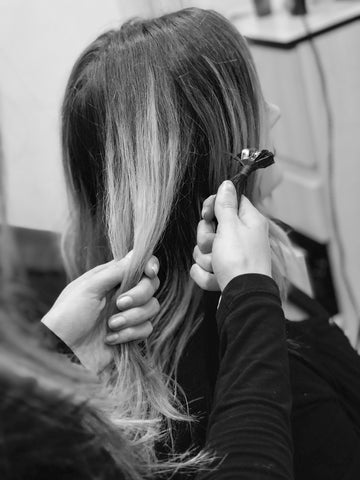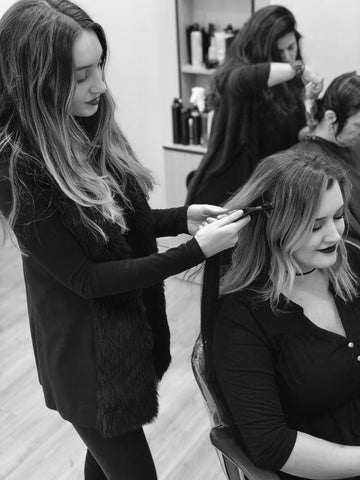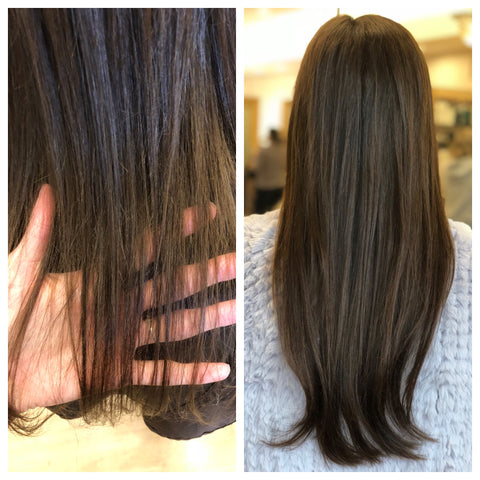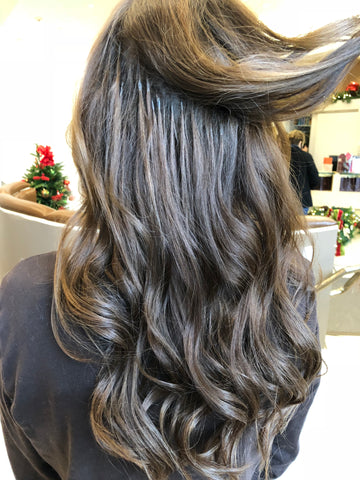
How Many Flat-Tip Extensions Do You Need for a Full Head?
Posted by Donna Bella on
One of the most difficult parts of the hair extension installation process is deciding how many packs to use. What makes this step so difficult is that there’s no clear cut formula. It will vary depending on your client’s hair thickness, texture, style, and desired end result, as well as the method selected. It’ll also depend on another key consideration: extension spacing. So how do hair extension stylists go about calculating the ideal number of packs, or arranging the perfect hair extension spacing for their clients—particularly for our newest hybrid method (Flat-Tip extensions)? We checked in with pro hair extension stylists Kayla Laumann (@kaylalaumann.hairdesign) and Mallory (Lane) Chafins (@mallorylanesalon) for their take on possible solutions to this problem.
First off, remember that this is a skill that takes practice. Both Kayla and Mallory initially struggled with quantity selection and spacing, sometimes with disastrous results. “When I first started out, it was hard for me to determine the number of packs for someone’s hair,” says Mallory. “I often liked to say the least amount also, because I didn’t want to over-charge the client. Let me tell you, the first time you run out of hair before you are done is the last time you under sell the amount of hair!” Kayla has been there, too. “Years back when I first started doing extensions, I was working on a model and I started applying the extensions in the lower nape and was working my way up. I was so overly worried it wasn’t going to blend that I just kept putting row after row, back-to-back bonds. I got to the sides and realized I was out of hair! AHH—nightmare!”
However, over time, both stylists learned how to use tried-and-true methods and some custom tricks. “I learned to add a pack to what I think is the amount it will require,” offers Mallory. “This way I know I am covered and whatever is left we can use to fill in whenever they need a little extra down the line.” Kayla sees her nightmarish experience as a major learning opportunity. “From that experience I learned placement was key, and even though I probably did have enough hair, I wasted so much of it cramming them into spaces that weren’t going to make any impact.” Her solution now? “When I have a client that has short hair, medium thickness, going longer, I will start applying in the front sides and work my way to the back. God forbid you ran out of hair—the client could at least pull their hair back in a low pony until you could get your hands on another bundle. In this instant world we now live in, the client appreciates being able to see the dramatic effect of their new hair right away!”
There are major benefits to getting this portion of the installation right—besides not running out of hair halfway through. Selecting the proper amount of hair and spacing it strategically throughout the client’s head will produce more accurate and fitting installations overall, finishing with a more natural look. Kayla puts it this way: “Extensions can be a very profitable service in the salon, so it’s important to be accurate when determining how many bundles will be needed. When determining this, you have to really inspect the client’s hair and ask yourself some questions. What is the perimeter of their hair like? Is it wispy, blunt, uneven? Is there layering? Does the client have any thin areas or bald spots where you would be applying the extensions? And the most important question of all, what is the look they are trying to achieve? These are the most important questions to ask because if someone has a very blunt haircut and they are looking for length, you’re going to need more hair than someone with very fine wispy ends, as those wisps will just blend right in.”
Here at Donna Bella, we have a longstanding system for determining the recommended quantity and spacing of hair extensions for a full-head installation (typically those installations where the primary objective is to add length). It depends on the thickness and relative bluntness of the client’s natural hair, and it goes something like this:
- the thicker or blunter the natural hair, the more extension packs you’ll need
- the thinner or wispier the natural hair, the fewer extension packs you’ll need
- you need fewer packs when using Tape-In than you would using I-Link or Kera-Link, because one Tape-In weft contains more hair than one I-Link or Kera-Link strand.
- the thicker the natural hair, the fewer rows you’ll skip when spacing
- the thinner the natural hair, the more rows you’ll skip when spacing
- in general, apply extensions side-by-side on each row
- always use a thick-hair spacing approach on the sides of the head


Good examples of Tape-In and I-Link spacing.
In order to match the thickness at the ends of the hair to the thickness at the roots, we recommend the following hair extension quantities:
|
Fine or Wispy |
Medium |
Thick or Blunt |
|
|
Strand-by-Strand |
4 - 7 packs |
5 - 8 packs |
8 - 10 packs |
|
Weft |
3 - 5 packs |
4 - 6 packs |
5 - 7 packs |
|
Hybrid |
4 - 6 packs |
5 - 7 packs |
6 - 9 packs |
Recommended: How Many Hair Extensions Do I Need for a Full Head?
“Sometimes with very blunt cuts you may have to soften those ends before applying extensions using a point cutting technique, or a thinning shear,” adds Kayla.
To arrange your extensions optimally around the surface of your client’s head, we recommend the following hair extension spacing:
|
Fine or Wispy |
Medium |
Thick or Blunt |
|
|
Strand-by-Strand (I-Link / Kera-Link) |
Side-by-side |
Side-by-side |
Side-by-side |
|
Weft & Hybrid (Tape-In, Flat-Tip) |
Side-by-side |
Side-by-side |
Side-by-side |
“You have to be very conscious of where you are placing the extensions,” clarifies Kayla. This is to make sure they are “completely undetectable along the hairlines and not placed too high where you can see them through the top layer of their hair.”
Even with these classic recommendations, though, you’re still left with ambiguity. Should you choose 6 or 7 I-Link packs for a full-head installation on a medium-thick client? Is your client’s hair more on the fine side or more on the medium-thick side?
As Mallory says, “these are just guidelines, and the current style/look and desired style/look is also a factor that should be weighed in.” In order to make the quantity selection and spacing process simpler or more straightforward, use the following tips, tricks, and cheats…
Quantity Selection
“The most accurate way for me to determine how many bundles of hair will be needed for someone adding length is to start on one side of the client’s head, grab the same amount of the client’s hair that would be in one of Donna Bella’s bundles, and work your way around the head to the other side (sometimes it helps to actually hold a Donna Bella bundle of hair in one hand, and then the client’s in the other to make sure you’re accurate). If you have split their hair into 5 sections, that would mean you would order 5 bundles. For me this is way simpler than some of the mathematic equations with measuring and dividing.”


Kayla comparing the thickness of her client’s hair section to a bundle of Donna Bella hair extensions.
When it comes to Flat-Tip extensions, Mallory has a few thoughts. “I have worked with the Flat-Tip extensions and I love them! They are very similar in application to the I-Link method. I sometimes feel as though you can order a little less than with I-Links because they have more of the spread of the Tape-In method.” That being said, we recommend shedding no more than 1 pack or so, as I-Link and Flat-Tip strands contain roughly the same amount of hair (about 1 gram).
If you prefer a more precise means of measurement, consider the relationship between hair thickness and hair weight. 18” Kera-Link, I-Tip, and Flat-Tip extensions come in strands that weigh approximately 1 gram each. 18” Tape-In comes in wefts that weighs approximately 3 grams each. You’ll want to install these strands/wefts on hair sections with roughly the same quantity of hair to match the extension, while taking into account that different lengths of hair will weigh different amounts. One route you could try is to measure and weigh the client’s hair: measure the length from root to tip, then collect the hair into a medium-high ponytail (if possible) and set it atop a handheld scale, lifting the scale so that it is roughly level with the ponytail itself. Let’s say your client’s hair is 12 inches or so long and weighs about 120 grams. She wants to get her hair to 18 inches long (a.k.a., 150% of her current length). Her destination hair weight would then be something like 180 grams (120 x 1.5). If she’s having 18” Flat-Tip extensions installed, that would mean that she would need approximately 9 packs of hair (1 pack of Flat-Tip extensions contains 20 strands, making a total of 20 grams of hair per pack; 180/20=9).
Spacing
“Spacing on a client’s head is also determined by the client’s hair density. You always want to put extensions right next to each other in each row, however, there can be space left in between each row moving up the head. If the client has fine hair more space can be left out, but for thick hair, little to no space is left out. Placement by the hairline is also a factor. I like to stick a tail comb where I believe the first or last extension should go in a row and then pull the hair left out over it. If you can see the comb through the hair, you will want to leave more hair out because the extension will also be seen.”
This rings true for Kayla, too, as she considers the client’s natural hair texture in the following circumstance: “If a client has naturally curly hair that they blow out smooth, and are having straight extensions installed, I would prefer to have a row of bonds one right next to the other, leaving a half inch or so between the next row up,” she explains. “The reason I wouldn't brick lay or leave hair between each bond is I don't want the left out curly hair winding around the bonds and creating unnecessary tension and knotting on the extensions. These half inch spaces leave enough hair in between to allow for proper brushing and comfort on the head.” When it comes to clients with other textures, Kayla revises her approach: “On the flip side, someone with super fine, straight hair I would start lower on the head and place the micro bonds back-to-back, and the rows close together (condensed lower on the head), so I can add all the hair in. That way the bonds will never be seen through the naturally fine hair because they won’t make it that high up the head.”


Kayla’s I-Link placement for straight, medium-fine hair.
For more help mastering your quantity selection and extension spacing, check out the following videos:
Donna Bella Hair Extension Tip: Placement
How to Install a Full Head of Hair Extensions
____________________________________________________________
Many thanks to Kayla and Mallory for offering their insights and tips! To learn more about their extension practice, visit their websites and Instagram profiles today!
Mallory (Lane) Chafins